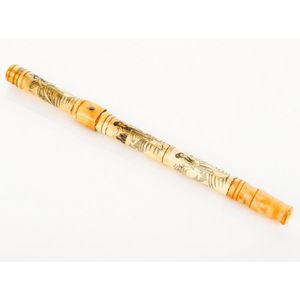Ivory Pipe and Buddha Statue
You must be a subscriber, and be logged in to view price and dealer details.
Subscribe Now to view actual auction price for this item
When you subscribe, you have the option of setting the currency in which to display prices to $Au, $US, $NZ or Stg.
- Ivory - Ivory is a hard white material that comes from the tusks of elephants, mammoth, walrus and boar, or from the teeth of hippopotamus and whales. The ivory from the African elephant is the most prized source of ivory. Although the mammoth is extinct, tusks are still being unearthed in Russia and offered for sale.
Ivory has been used since the earliest times as a material for sculpture of small items, both in Europe and the east, principally China and Japan.
In Asia ivory has been carved for netsuke, seals, okimono, card cases, fan supports, animals and other figures and even as carved tusks.
In the last 200 years in Europe ivory has been used to carve figures, for elaborate tankards, snuff boxes, cane handles, embroidery and sewing accessories, in jewellery and as inlay on furniture. Its more practical uses include being used for billiard balls, buttons, and a veneers on the top of piano keys.
The use and trade of elephant ivory have become controversial because they have contributed to Due to the decline in elephant populations because of the trade in ivory, the Asian elephant was placed on Appendix One of the Convention on International Trade in Endangered Species (CITES), in 1975, and in January 1990, the African elephant was similarly listed. Under Appendix One, international trade in Asian or African elephant ivory between member countries is forbidden. Unlike trade in elephant tusks, trade in mammoth tusks is legal.
Since the invention of plastics, there have been many attempts to create an artificial ivory - Hardstone - Hardstone is not a scientific name for a particular gemstone, but a word used to describe any one or more semi-precious stones used in jewellery and decorative arts, and can include jade, agate, onyx, rock crystal, amber, jet and carnelian. Softer stones and minerals such as soapstone, and alabaster and hard stones used in building such as marble or granite are generally excluded.
This item has been included into following indexes:
-
smoking accessories, pipes
- pipe stands/racks 25
- pipes, other 133
Visually similar items

A red, yellow and blue Zulu knobkerrie South Africa wood and telephone wire. Provenance: ex-Michael Green collection. Michael Green was a wealthy South African collector who moved to Tasmania after several decades of amassing an extensive collection of Afr

A lady's gold and diamond cocktail wristwatch, circa 1940's. Manual. Salmon gold dial with Arabic numerals, diamond set bezel and lugs. Unsigned 17 jewel Swiss movement. Tapered gas pipe bracelet. 9ct yellow gold. Total weight 33.14 grams. Length 18 cm

A green, white, red and green Zulu knobkerrie South Africa wood and telephone wire. Provenance: ex-Michael Green collection. Michael Green was a wealthy South African collector who moved to Tasmania after several decades of amassing an extensive collection

An emerald and diamond bracelet, set with two curved panels with a central row of round brilliant cut diamonds, flanked each side by emeralds, mounted in 18ct gold, total length 190 mm.
